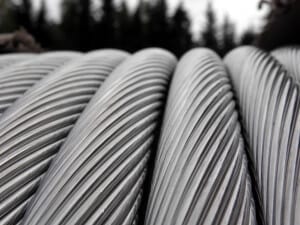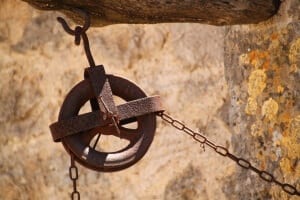There are many different types of lifting gear and lifting equipment on the market, and it can be hard deciding between them to choose the best for your lifting operation and the industry that you work in. Below we have compared two of the most common types of lifting gear that are used in conjunction with cranes, which are wire ropes and chain hoists.
What are wire ropes?
Most commonly made from stainless steel, they are constructed by twisting several metal wires together to form sturdy strands, which are then twisted around each other in a helix fashion.
 Steel wire rope
Steel wire rope
These strands are wrapped around a central core, commonly made from fibre, which leaves a finished product that is strong and reliable.
What are chain hoists?
Chain hoists, on the other hand, are constructed from chains, which is generally done using steel or zinc plated metal. They work in a similar way to rope, with the difference being that rather than several strands being wrapped together, a chain hoist features single chains linked together and fed through hooks with safety catches.
What are the similarities between ropes and chain hoists?
There are many similarities that makes them both suitable for a range of applications. Both are manually operated, they can both come in a range of heights and both are long lasting and maintenance friendly. They can also both be easily inspected, and are both manufactured with safety and reliability in mind.
What are the advantages of rope as compared to chain hoists?
Wire rope has a number of benefits over chain hoists which makes them the preferred solution in the lifting gear and equipment industry. Firstly, perhaps the biggest benefit of wire rope is the fact that it is constructed using multiple wires and strands. This means that the weight, pressure and stress of a load is spread out across multiple pieces of metal, rather than being reliant on one wire or strand alone.
Should one wire or strand break, it is possible for the lifting and lowering task to be completed, although we would recommend
ceasing any further operations with this gear afterwards. However, with a chain hoist, should one chain in the link break then the whole chain hoist is immediately rendered useless, and should this happen mid-operation, then there could be damage to the load.
 An example of a slightly older version of a chain hoist!
An example of a slightly older version of a chain hoist!
Of course, all of our products and equipment are reliably manufactured with a long service life in mind, and regular inspections will avoid this, but it is just something to consider. Another advantage is that a wire rope is much stronger than the latter, and can lift a great deal more. While the lifting weights vary between different types, you will find that chain hoists lift up to around 30,000Kg, while ropes can lift weights of around 90,000Kg.
Finally, wire ropes have more uses than chain hoists. They can be use as decorative balustrades in the home, as geothermal cables, as internal support for construction projects, and also for internal cabling within machinery and equipment to allow for the transfer of energy and force.
Wondering whether a wire rope or chain hoist is right for your application?
If you are unsure whether or not you should choose rope or chain hoist for your application, simply give one of our
team a call, and we would be more than happy to help.
 Steel wire rope
These strands are wrapped around a central core, commonly made from fibre, which leaves a finished product that is strong and reliable.
Steel wire rope
These strands are wrapped around a central core, commonly made from fibre, which leaves a finished product that is strong and reliable.
 An example of a slightly older version of a chain hoist!
Of course, all of our products and equipment are reliably manufactured with a long service life in mind, and regular inspections will avoid this, but it is just something to consider. Another advantage is that a wire rope is much stronger than the latter, and can lift a great deal more. While the lifting weights vary between different types, you will find that chain hoists lift up to around 30,000Kg, while ropes can lift weights of around 90,000Kg.
Finally, wire ropes have more uses than chain hoists. They can be use as decorative balustrades in the home, as geothermal cables, as internal support for construction projects, and also for internal cabling within machinery and equipment to allow for the transfer of energy and force.
An example of a slightly older version of a chain hoist!
Of course, all of our products and equipment are reliably manufactured with a long service life in mind, and regular inspections will avoid this, but it is just something to consider. Another advantage is that a wire rope is much stronger than the latter, and can lift a great deal more. While the lifting weights vary between different types, you will find that chain hoists lift up to around 30,000Kg, while ropes can lift weights of around 90,000Kg.
Finally, wire ropes have more uses than chain hoists. They can be use as decorative balustrades in the home, as geothermal cables, as internal support for construction projects, and also for internal cabling within machinery and equipment to allow for the transfer of energy and force.